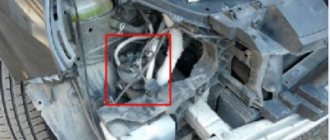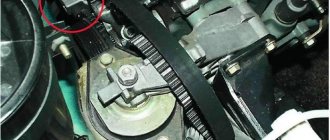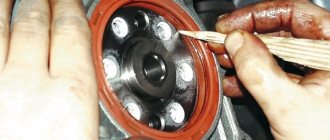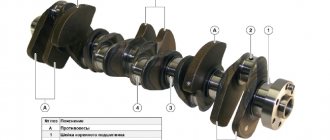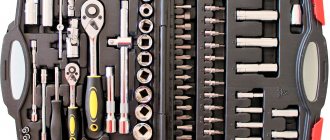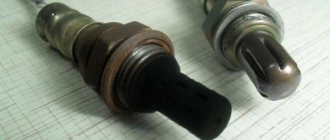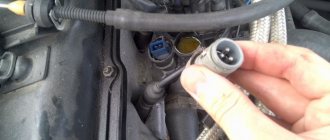Renault Megane 2 crankshaft sensor
Modern vehicles are equipped with an electronic control unit. It is the “brain” of the car. The process of starting the engine will directly depend on it. Also, with its help, the driver receives information about the condition of a particular unit. Manufacturers equip machines with measuring instruments to monitor the performance of the main components. One of these controllers is the crankshaft sensor on the Renault Megane 2. If it fails, the engine will not be able to operate normally, and the vehicle simply will not move.
Idle mode of an injection engine
The ECM (electronic engine management system) is responsible for maintaining idle speed at the required level. The ECM control unit (ECU), based on data received from various sensors, determines the amount and duration of fuel injection by injectors at idle, controls the idle speed regulator, and also sets the desired ignition timing required to maintain a certain crankshaft speed.
The order of operation of an injection engine in idle mode using the example of engine 2111 of VAZ 21083, 21093, 21099 cars
— Before turning on the ignition, the idle air control rod (IAC) is extended to its maximum and completely covers the cross-section of the bypass (air) channel in the throttle assembly.
— After turning the key in the ignition switch, the ECU determines the temperature of the coolant (signal from the temperature sensor - DT), determines that the throttle valve is completely closed (signal from the throttle position sensor TPS), the car is standing or driving (signal from the speed sensor - DS) .
Based on the data obtained, the position of the idle speed control rod is calculated at which it slightly opens the bypass channel to a certain clearance, which ensures the flow of air necessary for the engine to idle.
— After starting the engine, the control unit receives information from the crankshaft position sensor (CPS) about its rotation, from the temperature sensor about the coolant temperature, from the throttle position sensor that the damper is closed, from the mass air flow sensor (MAF) about the volume of incoming air into the engine, from the speed sensor about whether the car is standing or moving.
Based on the data received, the control unit sets the IAC rod to a position that provides optimal clearance of the air channel under the throttle valve. This ensures the flow of air into the engine cylinders necessary to maintain minimum stable speeds. In addition, it determines the duration and amount of fuel injection through the injectors, and determines the ignition timing.
As the engine warms up, the temperature of the engine increases, the temperature sensor signals this to the control unit and it moves the idle speed control rod, reducing the clearance of the air channel. The magnitude and duration of injection are reduced, and the ignition timing changes. The crankshaft speed gradually drops to 650-750 rpm.
If a warm engine starts and idles, then in the same way, based on the data received from the sensors, the control unit sets the regulator rod to the desired position.
In systems with feedback, the magnitude and duration of injection, and the ignition timing are calculated taking into account the readings of the oxygen sensor (poor-rich mixture). On a cold engine, the oxygen sensor does not work; readings from it begin to be taken as the engine warms up.
When you press the gas pedal, the throttle valve opens slightly, and the TPS signal about this is sent to the control unit. The engine idle mode stops. The regulator rod is set in such a position that when the throttle valve is suddenly closed, it quickly ensures the flow of additional air into the engine through the air duct and prevents “failure” in its operation.
If the car is moving with the gear engaged and the throttle completely closed (downhill, on a flat area, when braking with the engine, while changing gears), the ECU switches the system to forced idle mode (FIL) (fuel does not flow into the engine, it operates by inertia ).
Notes and additions
— Idle speed of a car engine is operation at low speeds (650-750 for injection VAZ 21083, 21093, 21099) with the throttle valve fully closed.
— In the event of a malfunction of the IAC, it is worth checking its electrical part.
Source
Location
Where is the crankshaft sensor on Renault Megane 2: this question is often asked by drivers who have recently used a vehicle of this brand. Since the device is important, the manufacturer has made it easier to access and installed a measuring controller on the left end of the cylinder block. A conductor extends from it, reaches a length of 70 cm and connects directly to the electronic control unit.
Location depending on the gearbox used on Renault Megane 2:
How to check if a measuring device is working correctly
First of all, the motorist must inspect the unit. There should be no corrosion, metal peeling, or rust on the surface. Next, an instrumental test is carried out, which consists of using a multimeter to determine the resistance:
It is worth noting that the crankshaft sensor on Renault Megane 2 cannot be repaired. If the controller does not work correctly, then the entire device must be replaced.
Engine Variations
Replacing the crankshaft sensor on cars differs only in engine models. Let's look at engines for Renault Megane 1 and 2.
- Type E, engine E7J, fuel – gasoline, 1.4 liters. In operation since 1988, i.e. most often found on Megane I. Designation “Energie-Motor”. The main difference is the V-shaped distribution of the intake and exhaust valves, as well as the designed cylinder block, with different directions of inlet and outlet of fuel-air mixture and exhaust gases - which ensures rapid gas exchange. The crankshaft is located at the bottom of the engine. It is connected by connecting rods to the pistons.
- Engine Renault Megane type F, petrol F3R/F4R or diesel F8Q/F9Q 2.0 liters. This is an earlier engine model that has been in service since the early 80's. Just like in the E engine, the crankshaft is located at the bottom. A more powerful engine, but has difficulties in repairing and installing its elements.
- Gasoline engine Renault Megane type K 1.6 liters. An improved version of the E-modification, where the dimensions for the pistons are increased and, accordingly, the volume is increased from 1.4 to 1.6 liters, without changing the engine dimensions. Designed for Renault Megane second generation. Both Megan models, both 1.4 and 1.6 liters, are 16-valve. The electronic ignition system is automated and does not require maintenance from you during use. The presence of separate coils for each cylinder in the corresponding spark plug, without a wire connecting them.
- Renault Megane 1.9 liter dCi diesel engine with direct fuel injection. A distinctive feature is the adjustment for different moments of movement of fuel injection into the combustion chambers.
Although different engine models can be used in a car, their essence is always the same. If the car does not start, there may be several reasons for this, and one of the main ones may be contamination or damage to the sensor. According to statistics, the crankshaft sensor fails quite rarely, but this is a clear reason for the inability to use any car, including the Renault Megane. The cause is often corrosion of the wiring, rather than damage to mechanical moving parts, since they simply are not there.
A fairly common problem can also be the simple adhesion of various metal and other particles to the sensor; after all, it is a magnet.
But it is still susceptible to mechanical damage, for example, the body of the device may crack or it may “move” a little from the desired position.
Its functional purpose is to read the dynamics of crankshaft torsion and create alternating current pulses with the transmission of information to the vehicle control unit (ECU).
Location of the crankshaft sensor on Renault Megane 2
In order to see where the crankshaft position sensor is located, you need to look at the left end of the cylinder block. In the case of a manual transmission, the clutch housing contains the DPKV. On Megan 2 with an automatic transmission, the sensor is located in the gearbox housing.
Sensor cost
Megan 2 uses an original Renault brand sensor, the article number of which is 8201040861. The price for a branded DPKV is 2000-2600 rubles. Also on Megane 2 cars there are sensors under the Nissan brand. They have catalog number 8200439315. The cost of such products is extremely high and often reaches 8,000-10,000 rubles. There are also analogues for the native DPKV. The best options from third-party manufacturers are presented in the table below.
Table - Well-proven analogues of the original DPKV Renault Megane 2
| Manufacturer | Catalog number | Approximate price, ruble |
| Delphi | SS10801 | 1100-1700 |
| Facet | 90199K | 1050-2000 |
| Mobiletron | CSE045 | 750-1200 |
| FAE | 79319 | 700-1200 |
| Behr-Hella | 6PU009163971 | 1700-2500 |
Methods for checking the crankshaft sensor
Checking the crankshaft sensor should begin with a visual inspection. There should be no cracks or other damage. The contacts of a serviceable DPKV are free of oxidation and contamination.
You can indirectly check the performance using an ohmmeter or multimeter. It is necessary to check the resistance between the contacts. In the case of a working DPKV, it should be from 500 Ohms to 10 kOhms.
You can check the DPKV using an oscilloscope. On the resulting graphs, you can track the violation of pulse formation and the presence of gaps in the signal supply to the electronic engine control unit.
Why do you need a recreation center?
The sensor is required to determine the following engine performance readings:
- recording the moment when the pistons pass the top and bottom dead centers in cylinders 1 and 4;
- fixing the position of the crankshaft;
- fixing the crankshaft speed;
When data is recorded, the measuring device transmits it to the electronic control unit. In turn, the electronic control unit processes the information and synchronizes with the working strokes of the engine.
This is interesting: Do-it-yourself car battery repair: instructions
Required Tools
To replace the crankshaft position sensor on Megan 2 with your own hands, you need the tools from the list given in the table below.
Table - Tools required to replace the crankshaft sensor
| Name | Note |
| Spanner | Set |
| Head | "on 10" |
| Screwdriver | Medium size, flat blade |
| Vorotok | With ratchet and extension |
| Penetrating lubricant | For releasing rusted threaded connections |
| Rags and wire brush | For cleaning work surfaces from dirt |
Search, removal and installation
According to the functionality, the crankshaft sensor is located near the connection between the automatic transmission box and the car engine. To get to it, you need to remove the air conditioner inlet and filter housing. The position of the device at a dead center indicates the need for cleaning or replacement.
Although it is worth noting that on Renault Megane II with an engine capacity of 2.0 rather than 1.6, the crankshaft and sensor are located in a slightly different place - under the battery. And its removal and replacement are carried out using a pit or a lift, i.e. from below the car. To remove the sensor you will need the following tools:
- extension cords;
- cardan coupling;
- a wrench with a head of at least 10, but preferably 11 mm, and ideally about 1 meter long;
- if necessary, carrying for better lighting.
- First of all, we remove the battery pad. Next, using a thin slotted screwdriver, separate the connector retainer and the wire block. If difficulties arise, then simply move the block as long as the length of the wires is enough, then the process of removing the block will not be difficult. Now you need to unscrew the two mounting bolts and remove the device.
- It is important not to lose the rubber gasket and make a note of where it was installed. If necessary, clean or replace the sensor. Cleaning it is not difficult, you just need to wipe it with a clean rag soaked in gasoline. Often this helps and the problem can be solved in this simple way. However, in any case, be careful when cleaning - this is a rather fragile element.
- After installing the device, it is necessary to configure the programming of the toothed section of the flywheel. This is done by decelerating twice in sequence in third gear at a maximum speed of 4,000 rpm. Until the fuel is supplied again, which indicates normal operation of the ECU.
It is advisable to use a diagnostic tool for programming ET089: “Programming the target section of the flywheel ring gear.”
Replacing the sensor is not problematic; even a novice car enthusiast can do this after reading the instructions. The difficulty, as was said at the beginning of the article, is the differences in engine models on Megan and also the differences in models and locations of the crankshaft sensor itself. Although since 1985 it has been available in the only current form: 8200673202 and 8200647554.
Self-replacement of the sensor on Renault Megane 2
Replacing the crankshaft position sensor on Megan 2 is carried out according to a step-by-step algorithm, detailed instructions for which are presented below.
The latch often breaks off and disconnecting the block becomes problematic. To solve the problem, it is recommended to first remove the sensor mount, and only then proceed to the block. Otherwise, attempts to loosen the connector may cause it to break.
Source
